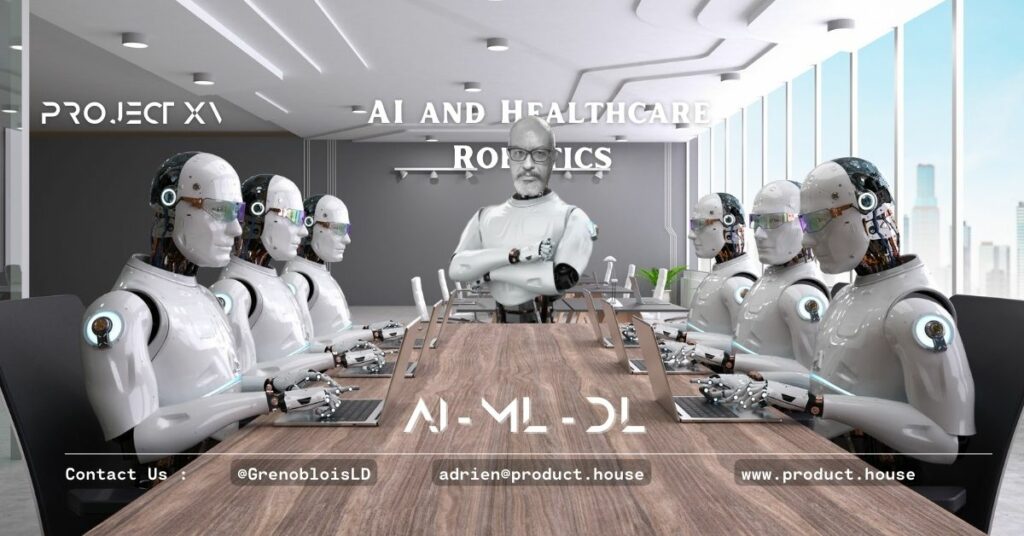AI and Healthcare Robotics: Improving Patient Care and Outcomes

The healthcare industry is one that is heavily reliant on technology. With the rise of artificial intelligence (AI) and robotics, healthcare professionals are now able to provide better care and improved outcomes for patients. In this article, we will explore how AI and healthcare robotics are changing the face of healthcare.
What are Healthcare Robotics?
Healthcare robotics refers to the use of robots and other automated machines in the healthcare industry. These machines can be used in a variety of ways, including surgery, patient monitoring, and medication management. Healthcare robots are designed to perform tasks that are repetitive, dangerous, or require high precision. By automating these tasks, healthcare professionals can focus on providing better care to their patients.
How is AI Used in Healthcare Robotics?
AI is an important component of healthcare robotics. AI algorithms can be used to analyze large amounts of patient data, identifying trends and patterns that can help healthcare professionals make better decisions. AI can also be used to improve the accuracy of medical diagnosis and treatment.
One example of how AI is being used in healthcare robotics is in the development of surgical robots. These robots use AI algorithms to assist surgeons in performing complex surgeries. They can also be used to perform minimally invasive surgeries, reducing the risk of complications and improving patient outcomes.
Benefits of AI and Healthcare Robotics
The use of AI and healthcare robotics offers many benefits for both patients and healthcare professionals. For patients, these technologies can lead to better outcomes, faster recovery times, and improved quality of life. Healthcare professionals can benefit from increased efficiency, reduced workload, and improved accuracy in diagnosis and treatment.
Another benefit of AI and healthcare robotics is that they can help reduce healthcare costs. By automating tasks and improving efficiency, healthcare providers can save money on labor costs and other expenses. This can help make healthcare more affordable and accessible for patients.
Challenges of AI and Healthcare Robotics
While there are many benefits to using AI and healthcare robotics, there are also challenges that need to be addressed. One of the biggest challenges is the cost of implementation. These technologies can be expensive, and many healthcare providers may not have the resources to invest in them.
Another challenge is the impact on healthcare professionals. As healthcare robotics become more advanced, there is a risk that they could replace some healthcare jobs. However, many experts argue that these technologies will create new types of jobs and increase the demand for skilled healthcare professionals.
Future of AI and Healthcare Robotics
The future of AI and healthcare robotics is bright. As technology continues to advance, these technologies will become even more advanced and sophisticated. We can expect to see more use of AI in diagnosis and treatment, as well as in the development of new healthcare robots.
Another area where we can expect to see growth is in the use of AI and healthcare robotics in remote healthcare. These technologies can be used to monitor patients remotely, allowing healthcare professionals to provide care from a distance. This could be particularly useful in areas where access to healthcare is limited.
Conclusion
The use of AI and healthcare robotics is transforming the healthcare industry, improving patient care and outcomes. While there are challenges to be addressed, the potential benefits of these technologies are significant. As we look to the future, we can expect to see more use of AI and healthcare robotics in the development of new treatments, surgeries, and patient care strategies.
Article Reminders:
- Healthcare robotics refers to the use of robots and other automated machines in the healthcare industry.
- AI algorithms can be used to analyze large amounts of patient data, identifying trends and patterns that can help healthcare professionals make better decisions.
- Healthcare robotics can lead to better outcomes, faster recovery times, and improved quality of life for patients.
- The use of AI and healthcare robotics can help reduce healthcare costs and increase efficiency.
- Challenges of AI and healthcare robotics include the cost of implementation and the impact on healthcare professionals.
FAQs
- What are healthcare robotics?
Healthcare robotics refers to the use of robots and other automated machines in the healthcare industry to perform tasks that are repetitive, dangerous, or require high precision. - How is AI used in healthcare robotics?
AI algorithms can be used to analyze large amounts of patient data, identifying trends and patterns that can help healthcare professionals make better decisions. AI can also be used to improve the accuracy of medical diagnosis and treatment. - What are the benefits of AI and healthcare robotics?
The use of AI and healthcare robotics offers many benefits for both patients and healthcare professionals, including improved outcomes, increased efficiency, reduced costs, and improved accuracy in diagnosis and treatment. - What are the challenges of AI and healthcare robotics?
Challenges of AI and healthcare robotics include the cost of implementation and the impact on healthcare professionals, as there is a risk that they could replace some healthcare jobs. - What is the future of AI and healthcare robotics?
As technology continues to advance, we can expect to see more use of AI and healthcare robotics in the development of new treatments, surgeries, and patient care strategies. - What is remote healthcare?
Remote healthcare is the use of technology to monitor patients remotely, allowing healthcare professionals to provide care from a distance. - What are some examples of healthcare robots?
Examples of healthcare robots include surgical robots, medication management robots, and patient monitoring robots. - How can AI and robotics improve patient outcomes?
AI and robotics can improve patient outcomes by providing more accurate diagnoses, reducing errors in treatment, and improving the efficiency of healthcare delivery. - How can healthcare providers ensure ethical use of AI and robotics?
Healthcare providers can ensure ethical use of AI and robotics by developing policies and procedures to ensure that they are used in a responsible and safe manner. - What is the potential impact of AI and robotics on healthcare costs?
The use of AI and robotics in healthcare has the potential to reduce healthcare costs by improving efficiency and reducing the need for manual labor.
Case Studies:
- Da Vinci Surgical System by Intuitive Surgical
- Paro Therapeutic Robotic Seal for Dementia Patients by Intelligent Systems Co.
- Moxi Robot by Diligent Robotics
Examples of Use:
- Surgical robots for minimally invasive procedures and complex surgeries.
- Medication management robots for dispensing and administering medication.
- Patient monitoring robots for remote patient monitoring.
- Rehabilitation robots for physical therapy and rehabilitation.
- Robotic exoskeletons for patients with mobility issues.
Glossary:
- Healthcare Robotics: The use of robots and other automated machines in the healthcare industry.
- Artificial Intelligence (AI): The ability of machines to perform tasks that normally require human intelligence.
- Patient Monitoring: The use of technology to monitor patients’ vital signs and other health-related information.
- Minimally Invasive Surgery: Surgery performed using small incisions and specialized tools.
- Rehabilitation: The process of restoring a patient’s ability to function normally after an injury or illness.
- Robotic Exoskeleton: A wearable device that assists with movement and mobility.
Quiz Questions:
- What is healthcare robotics?
- How is AI used in healthcare robotics?
- What are some benefits of AI and healthcare robotics?
- What are some challenges of AI and healthcare robotics?
- What is remote healthcare?
- What are some examples of healthcare robots?
- How can AI and robotics improve patient outcomes?
- How can healthcare providers ensure ethical use of AI and robotics?
- What is the potential impact of AI and robotics on healthcare costs?
- What is a robotic exoskeleton?





